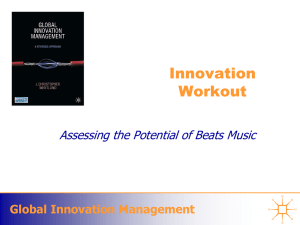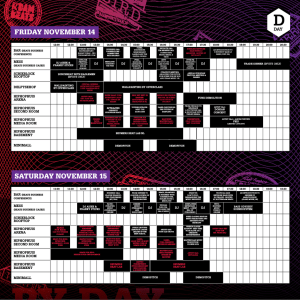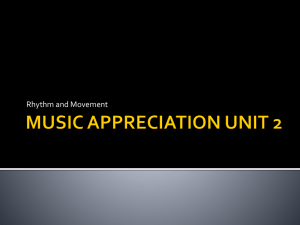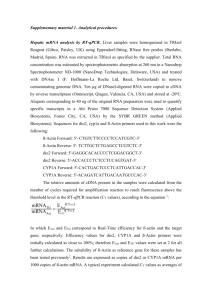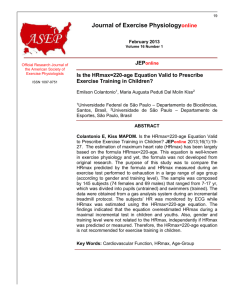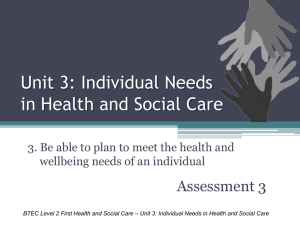Continuous and intermittent exercise in chronic heart failure
advertisement
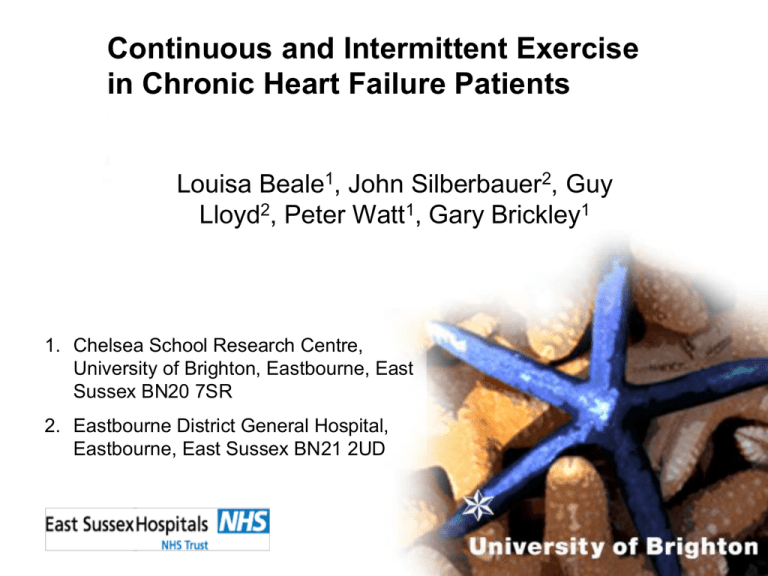
Continuous and Intermittent Exercise in Chronic Heart Failure Patients Louisa Beale1, John Silberbauer2, Guy Lloyd2, Peter Watt1, Gary Brickley1 1. Chelsea School Research Centre, University of Brighton, Eastbourne, East Sussex BN20 7SR 2. Eastbourne District General Hospital, Eastbourne, East Sussex BN21 2UD Introduction: Exercise for Chronic Heart Failure (CHF) patients Continuous (below VT) (Meyer (T), 2005; Gordon & Scott, 1995, Demopoulos, 1997) • Similar physiological demands in individuals • Moderate and maintainable intensity • Above VT increases LV wall stress and decreases LV function Intermittent (Interval) (Meyer (K), 1996 & 1997, Wisløff et al, 2007) • Greater stimulus to the periphery without over-taxing weakened heart • Allows challenge to heart’s pumping capacity • Greater improvements than after continuous training BACR guidelines • 60-75/80 % predicted HRmax OR 40-60/70% HRR (Karvonen) • β-blockers: deduct 20-30 beats.min-1 from HRmax • RPE 11-14 Aim To compare exercise training intensities derived from cardiopulmonary exercise testing with current exercise prescription guidelines in CHF • What are the acute responses to continuous (CON) and intermittent (INT) exercise at an intensity equivalent to 90% VT? • Are current BACR guidelines likely to prescribe an exercise intensity at or below VT? Methods Patients: 10 (8 male 2 female) CHF (NYHA Class II-III) Mean ± SD Age (yr): 75 ± 8 Height (m): 1.74 ± 0.12 Body mass (kg): 85 ± 16 . VO2 peak (ml.kg.min-1) : 15.4 ± 4.5 Medication: β-blockers n= 9, anti-arrhythmic n = 3 Exercise Tests: Maximal exercise test cycle ergometer ramp rate 10 W/min Measurements: Resp. gas exch., HR, BP, RPE 2 x 20 min exercise bouts, 1 week apart, randomised, equal work done Continuous: 90% VT Intermittent: work phase 110% RCP: 30s (x 13) recovery phase: 60s (x14) EXERCISE DOMAIN Exercise Intensity (W) 1 2 EXTREME VO2 PEAK 90W SEVERE RCP HEAVY VT average workload 45W MODERATE 25W 20 REST Continuous Intermittent Time Results Comparison of exercise data at VT with average values during CON and INT Mean ± SEM VT CON INT Average HR (beats.min-1) 80 ± 3 78 ± 3 77 ± 3 Average VO2 (ml.min-1) 810 ± 98 859 ± 86 869 ± 83 METS 3.0 ± 0.8 3.0 ± 0.7 3.1 ± 0.5 RPE 11.7 ± 0.9 12.1 ± 0.6 RPP* 101 ± 5 98 ± 5 * BP(mm.Hg-1) x HR (beats.min-1)/100 No significant differences were found HR response to continuous and intermittent exercise in CHF patients and control subjects HR during continuous exercise @ 90% VT relative to BACR guidelines Peak HR and target HR ranges recorded during a maximal exercise test vs. predicted values HRmax (beats.min-1) HRR (beats.min-1) -1) 60% HRmax (beats.min Recorded Predicted -1 Maximum heart rate (beats. min(beats.min ) 105 ± 5 ± 4 40% HRR )118 Heart rate reserve (beats. min ) 48 ± 5 61 ± 5 60% maximum heart rate (beats. min ) 63 ± 3 71 ± 2 -1 80% maximum heart rate (beats. min ) 84 ± 4 94) ± 3 80% HR (beats.min max 40% heart rate reserve (beats. min ) 76 ± 3 81 ± 2 70% heart rate reserve (beats. min ) 90 ± 4 99 ± 2 70% HRR (beats.min-1) -1 -1 -1 -1 -1 -1 Recorded Predicted 105 ± 5 48 ± 5 63 ±p value 3 * 76 ± 0.023 * 0.02 * 0.02 * 84 ± 0.024 * ** 0.02 0.00 * ** 0.02 0.00 90 ± 4 118 ± 4 61 ± 5 71 ± 2 81 ± 2 94 ± 3 99 ± 2 * * * * * ** * ** * p< 0.05: difference between recorded and predicted values ** p< 0.05: difference between % maximum or peak HR and %HRR methods *p< 0.05: difference between recorded and predicted values **p< 0.05: difference between % HRmax and %HRR methods Practical Implications • Exercise at or just below VT is well-tolerated, and intermittent is an alternative to continuous (next study will investigate continuous vs. intermittent at a higher intensity) • Difficulty of accurate exercise prescription in CHF patients without CPET • Don’t rely on % predicted HRmax to guide exercise intensity • 40-70% HRR does not correspond with 60-80% HRmax • HRR (Karvonen) method is likely to prescribe exercise at or above RCP, i.e. heavy exercise domain Continuous and Intermittent Exercise in Chronic Heart Failure Patients Louisa Beale1, John Silberbauer2, Guy Lloyd2, Peter Watt1, Gary Brickley1 1.Chelsea School Research Centre, University of Brighton, Eastbourne, BN20 7SR 2. Eastbourne District General Hospital, Eastbourne BN21 2UD ANY QUESTIONS? Comparison of HR as % HRR, and VO2 as % VO2R at VT and during CON and INT Identifying Ventilatory Threshold Identifying RCP Identifying VT and RCP HR response to continuous and intermittent exercise in CHF patients and control subjects
